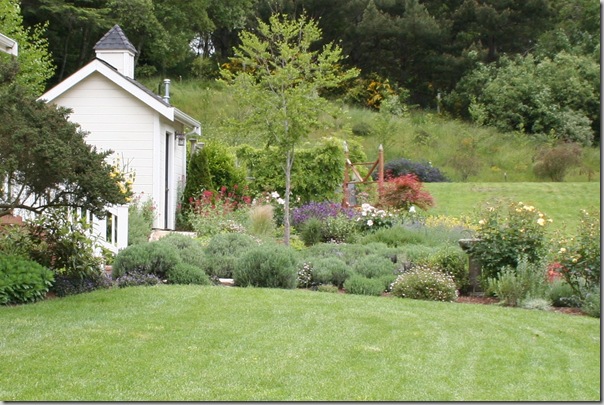
Lawn care, at first glance, seems pretty straightforward. Mow, water, apply various bagged items, and take the time to frolic playfully on your fancypants expanse of greenery.
But after owning a lawn for any period of time, most of us start to ponder the deeper questions surrounding lawn. Questions like, “dang, why does my water bill double every summer?” and “why does the pull-cord on my mower have to be such a pain?” and, “geez, where are all the birds and bugs around this joint?”. Issues like these are enough to harsh anyone’s lawn mellow.
The standard rallying cry in response to this is “ditch your lawn!”. While minimizing and replacing your standard American lawn with front yard food or native plants is an awesome goal, it can be an expensive and time-consuming task to tackle all in one go.
Is there an alternative to the American lawn that doesn’t involve outright removal? I’d offer an emphatic yes. Here are six ways to hack your lawn care routine and have an alternative lawn, without ripping it out:
Skip the blue pelletized big-agribusiness lawn fertilizers and scatter some clover seeds instead
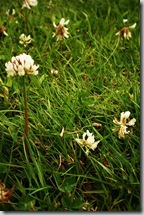 According to Sue Sweeney, old-fashioned lawns used to have about 1/3 white Dutch clover added to the seeding mix, because clover is a nitrogen-fixer – it adds nitrogen to the soil just by growing there. Since nitrogen’s in charge of the green growth side of things, clover’s a perfect lawn companion.
According to Sue Sweeney, old-fashioned lawns used to have about 1/3 white Dutch clover added to the seeding mix, because clover is a nitrogen-fixer – it adds nitrogen to the soil just by growing there. Since nitrogen’s in charge of the green growth side of things, clover’s a perfect lawn companion.
What you should know: clover’s slippery to run on, so it’s not good for too many racings-about, and since clover is also great for attracting pollinators like honeybees and your local native bees, if anyone in your home has a bee allergy of some kind it might not be the best.
But to me, it seems like one of the simplest ways to reduce your footprint and bring life to your lawn.
Vegetarians: quit feeding animals to your plants
While organic fertilizers are the best choice for our gardens (they’re slow-release and nourish the worms and beneficial microbes in the soil), unfortunately the blood meal, bone meal, feather meal, and fish meal are made of exactly the ingredients they sound like. They’re waste products from meat operations. Even as a meat-eater, I try to buy from small, organic local farms that raise pastured animals, and I’m not convinced there is a fertilizer option that supports that. So how can you give your lawn a boost without sacrificing your values?
Try these animal-friendly options:
Alfalfa meal has nitrogen, potassium and phosphorus, plus a natural growth stimulant called triacontanol that gives plants some superpower growing mojo.
Kelp meal is high in micronutrients and has both gibberellins and auxins, more of those natural growth hormones that plants make for themselves.
Compost is low in nutrients but encourages all the beneficial microbes and worms to do their thing and produce natural fertilizers. So it’s great for helping your lawn become more self-reliant. And even if you opt for a normal organic fertilizer, find an OMRI-listed one, which has organic and non-GMO ingredients.
Learn more about making your own veganic fertilizers here.
Grow your own on your lawn
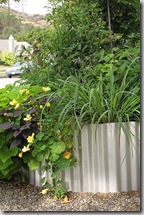 As countless people in my hippie-town have found, growing food on your lawn is pretty dang easy. You construct a raised bed on your lawn (8″ or taller), put some cardboard down at the bottom of it to keep the lawn from growing up through, fill with soil and plant!
As countless people in my hippie-town have found, growing food on your lawn is pretty dang easy. You construct a raised bed on your lawn (8″ or taller), put some cardboard down at the bottom of it to keep the lawn from growing up through, fill with soil and plant!
Keep in mind that if you have some lawn around it, you’ll want to leave easy mowing access on all sides. But this is one of the easiest ways to make your lawn a place you visit and use and not just a dead zone of green monoculture.
(Read The Edible Front Yard for tips on making this pretty rather than farm-like. The photo shown is from her book, illustrating a hellstrip planting with an industrial-cool corrugated metal raised bed.)
Ditch the corded electric mower and the retro-style push mowers
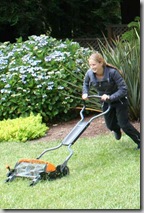 For a while, the latest trend was electric mowers. The problem with a corded electric mower should be obvious to anyone who has ever run over the cord while vacuuming. A mower has blades down there.
For a while, the latest trend was electric mowers. The problem with a corded electric mower should be obvious to anyone who has ever run over the cord while vacuuming. A mower has blades down there.
And while the ones with batteries sound good in theory, my landscaper friends scoff at their performance, and the eco-peeps say the (mostly lead) batteries they use are pretty harsh on the environment.
Then those old-style push mowers came into fashion. Which is cool, except they’re heavy and don’t work that well unlike generic Cialis. I have a friend who bought a push mower, lasted about three rounds with it, and hired a lawn service. And she works out!
That’s why my latest love is the Fiskars Momentum Mower – kind of a new-skool take on the push mower that solves the issues the old ones had. It’s been one of the top-selling mowers on Amazon for some time, and has gotten incredible reviews. (I love mine!) I tested it out on a few stunt lawns, and in my opinion it’s far and away the best option out there.
Have a green lawn without watering much
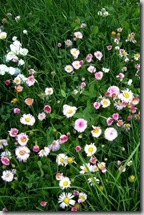 Have you ever noticed that when you don’t water the lawn, the only thing that stays green are the weeds? Well, why not take advantage of the fact that some other types of plants can co-mingle with your lawn and stay green with less juice?
Have you ever noticed that when you don’t water the lawn, the only thing that stays green are the weeds? Well, why not take advantage of the fact that some other types of plants can co-mingle with your lawn and stay green with less juice?
Wooly thyme, blue star creeper (in shade), Roman chamomile, dwarf yarrow, and English daisy (shown) are all things that can be seeded or planted in your lawn come fall (plant or seed with some compost and time it with the first fall and winter rains) so that next summer, your low-water lawn has some color and scent to enjoy.
Two sites to check out: Hobbs and Hopkins Lawn Flower Mixes, and Ecolawn. As a bonus, a lot of these lawn companions attract the happy bees and pollinators that make your garden fun to be in.
Dodge the lawn peer-pressure thing
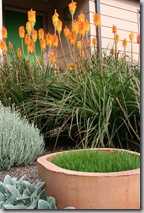 If you have ditched your lawn, my local friend-in-the-dirt Donna Wildearth came up with a clever prop to sidestep the haters. Just plant up a cool little pot of grass and set it within your landscaping.
If you have ditched your lawn, my local friend-in-the-dirt Donna Wildearth came up with a clever prop to sidestep the haters. Just plant up a cool little pot of grass and set it within your landscaping.
Anyone wondering why you don’t have a lawn can be deftly reassured that indeed, lawn is a vital part of your design scheme (and hey, a small patch like that is a lot easier to maintain!).
(Thanks to Donna for letting me show off her bit of lawn!)
Photo credits: clover by steve p2008 on Flickr, front yard raised bed by Ivette Soler from her book The Edible Front Yard (copyright Ivette Soler and courtesy Timber Press), English daisy by Hobbs and Hopkins.
26 responses to “Lawn Hacks for Organic Gardening Geeks”
[…] Genevieve Schmidt : North Coast Gardening : Arcata, CA […]
[…] Genevieve Schmidt : North Coast Gardening : Arcata, CA […]
[…] Genevieve Schmidt : North Coast Gardening : Arcata, CA […]
[…] Genevieve Schmidt : North Coast Gardening : Arcata, CA […]
[…] Genevieve Schmidt : North Coast Gardening : Arcata, CA […]
[…] Genevieve Schmidt : North Coast Gardening : Arcata, CA Douglas Owens-Pike : Energyscapes : Minneapolis, MN […]
[…] Genevieve Schmidt : North Coast Gardening : Arcata, CA […]
[…] Genevieve Schmidt : North Coast Gardening : Arcata, CA […]
Gen – Loved your tip about meat industry waste products as organic fertilizers. I find my self using kelp and fish oil but am now wondering about these too. We are quickly using up all the resources our planet offers. I would simply advise no fertilizer on lawns anyway. Just makes ’em grow too much my father always said …
Thanks, Saxon. Yes, I’d like to know more about how kelp is sourced. I see a call to my favorite soil companies in my immediate future.
Gen, these are all great ideas! I’ve been happy using alfalfa meal on my lawn, and recommended it to a neighbor. Unfortunately, her pot bellied pig was a little *too* happy with it! Thanks for the heads up on the Fiskars mower, it sounds like an exciting innovation for those of us who want a small patch of lawn.
Jocelyn, I am laughing at the visual of a potbellied pig happily rolling in and eating the alfalfa meal. Hah! Too funny.
I’ve just transitioned over to the Fiskars mower and I am just delighted at not having to do the gas-mower ordeal anymore. Last night I string-trimmed my front yard weeds at the curb and came in exhausted, reminded of why I hate power tools like that. Give me a nice ergonomic hand tool anyday.
Gen, What a great post filled with lots of easy to implement advice. I like the way you’ve broken things down into different options so we can pick & choose what works best for us now. I can attest to the traditional reel mower being very hard to use. When we moved into our house we found an old reel mower in the back of our shed. My husband actually used it once or twice to cut the lawn but we quickly switched to a more traditional mower since it was taking hours to mow with the old-school one.
I share your aversion to animal waste but have some bad news about kelp – it’s horrible for the ocean to remove the stuff! We have a guest rant coming soon from Linda Chalker-Scott about it. Damn.
Love all the helpful hints for those who still want their lawn but are concerned about the planet. I’ve been happy using alfalfa as well and recommend it to anyone who’ll listen to me! I haven’t tried the Fiskars mower yet, but seeing that photo of you frolicking around on the lawn with it is tempting me – dang you make it look fun!! Thanks for the great ideas, Gen!
Amazing how clover has been demonized! Terrific that you’re getting the word out.
I love my UC Verde grass that I put in two years ago! Freshly mowed, you’d never realized it wasn’t traditional turf grass (although I mow it much less often). The downside is it goes dormant in winter, but hey, isn’t that what grass in California is SUPPOSED to look like?
Okay – (and I am NOT saying this because you so lovingly mentioned me in your post!) This is a FANTASTIC contribution! I love every single one of your “six ways” – especially the white clover and not feeding animals to your lawn! There is a lawn across the street that is full of white clover, and it comes alive when blooming! Not a monoculture at all, with bees and butterflies visiting constantly. And the point about blood meal and bone meal is VERY well taken – there are other, better choices that are more humane.
Wonderful, wonderful job as usual, sweet golden girl!
XOXOIvette
Great suggestions, Gen, for transitioning away from the traditional lawn toward a sustainable one. For those who really love lawn, this is the way to go. And I adore that little pot of grass — so cute!
Wot a lot of great ideas here!
perversely I love the cheekiest the most – the pot of grass. That has humour!
Thanks for sharing
best
R
WOW so many ideas. I have very little grass left (a little more than a pot) and will try the thyme, clover and daisy seed this fall. Thanks for the advice on the Fiskars mower – will look into that one.
[…] Webber : Hegarty Webber Partnership : Bristol, UK Jocelyn Chilvers : The Art Garden : Denver, CO Genevieve Schmidt : North Coast Gardening : Arcata, CA Douglas Owens-Pike : Energyscapes : Minneapolis, […]
[…] Genevieve Schmidt in Arcata, CA […]
[…] Genevieve Schmidt in Arcata, CA […]
Thanks for all the helpful information found on here…. I always use poultry dung as organic fertilizer.
[…] Genevieve Schmidt : North Coast Gardening : Arcata, CA […]
[…] Genevieve Schmidt : North Coast Gardening : Arcata, CA […]